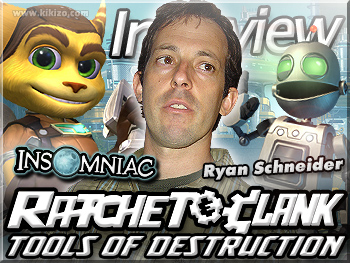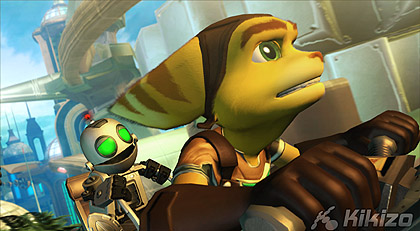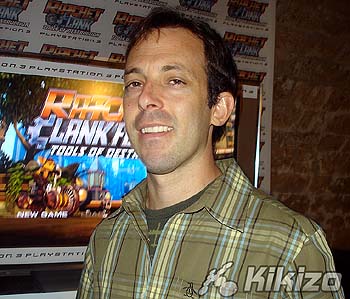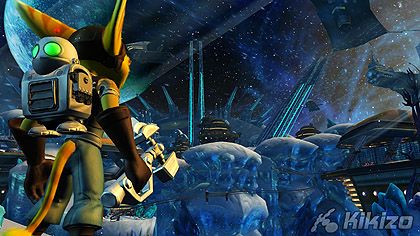Ratchet & Clank PS3: Insomniac Interview
We talk to Insomniac's Ryan Schneider to learn how Mario Galaxy draws inspiration from the Ratchet games, and chat about the series' PS3 debut, Tools of Destruction.
Page: 1 2
By Adam Doree
There's a good reason why the Ratchet and Clank series has been one of PlayStation's most celebrated over the years. It's gorgeous looking, easy to play and challenging to truly conquer. And based on our latest playtest of the series' all-new PlayStation 3 outing, Ratchet & Clank Future: Tools of Destruction (or just Ratchet & Clank: Tools of Destruction in Europe), there's little reason to doubt that the team at Insomniac Games has refined the classic formula on all counts.

In one of the most visually vibrant and shiny titles yet seen for the powerful Sony console, talking monkey Ratchet and his baby robot friend Clank are embarking on a totally new adventure that not only adds cool new weapons and fantastic environments to the mix, but actually makes worthwhile use of the Sixaxis controller as well - although Insomniac wouldn't be drawn on rumble functionality at the time this interview was conducted on a fancy press trip in Croatia just recently.
Ryan Schneider is the Marketing Director at the acclaimed Insomniac studio, creators of the Ratchet series from the beginning as well as the popular PS3 launch title, Resistance: Fall of Man. However, his role at the company is multifaceted; he's responsible for all studio marketing activities, including Insomniac's online community, as well as collaborating with creative directors and contributing to the game production process itself - he helped create aspects of the back-story in Resistance, for example, as well as one of the online multiplayer modes.
So, it's safe to assume he's all clued up about the release of Ratchet and Clank for PS3 early next month, and we have some questions for him, as you might expect.
![]()
Kikizo: You've said that some inspiration is taken from games and movies, but have you found influences of Ratchet in other games?
Ryan Schneider: Yeah, I think that it's flattering... well OK, first of all, there was a PlayStation 2 game which I won't name, that was more or less a direct rip-off of Ratchet and Clank. There's evidence all around us I think, of certain games that have borrowed from Ratchet and Clank. One that we're even extremely flattered by is Super Mario Galaxy, with their spherical worlds; we did spherical worlds in Going Commando, and Up Your Arsenal. It would be amazing to think that Miyamoto-san thought that was so cool that he wanted to incorporate it into Mario Galaxy. Granted, he's doing it in a different way, but it's still a spherical world, so it's flattering to see those sorts of things.
Kikizo: Can you tell us a bit about the creative process of designing a Ratchet game for PS3?
Schneider: The way we make our games, we have a pre-production, and then production. And we spend a lot of time in pre-production working with our designers and our artists, setting up our tools and technology, and making sure that everything is integrated. And obviously our designers have a huge role in that. Arguably, the people who have the biggest say in the matter are our project managers; they're arguably our most important component because they tell us what is possible within the time constraints, and they help us define what we can and can't do, within the deadline structure. So they really make sure that while we're ambitious, we're realistic. That's a key component to production. And then we have a creative director, who's Brian Allgeier. He's been the lead designer for every Ratchet and Clank game, and he's the one who is also really the singular keeper of the vision for the franchise. And essentially my job is to take his creative vision and work with Sony Europe, America and Japan, and help translate that so that it's properly communicated to you, to the consumers and retailers as well. So we have a lot of different facets each with their specialised job, making sure that we create a game that's unique, large and epic.
Kikizo: We talk a lot about casual game market now with the introduction of Wii and things like Brain Training on the DS. Do you think Ratchet and Clank can better serve this market?
Schneider: It can. Casual games can apply to ratchet and Clank. And the reason why, is Ratchet and Clank is a highly accessible game. What I mean by that is that hardcore gamers find a lot to do in Ratchet and Clank; they have the weapons upgrade system, the RPG dialogue, using the Sixaxis, the varied gameplay types, all the exploration. But at the same time it's very accessible for new gamers as well. What we see a lot in our fan mail is from kids who are like six, to big kids, like grandparents! And they're all so enthusiastic, saying, "hey this game, we play as a family, I sat down and wanted to watch my son or daughter play, next thing I know, I'm playing it". So I think it's going to be a bridge to sort of a casual game for people who want casual games, and a bridge for people who want hardcore games.
Kikizo: When we think about the previous games, one of the biggest features has been the weapons, and how cool they are. You've talked about the weapons upgrade system, but can you tell us more about the weapons themselves? Will any be making a return?
Schneider: I'll talk about some of my favourites! The Tornado Launcher, without question, is my favourite, although it's a combat device... actually it's a weapon, I take that back! The Tornado Launcher, it launches out tornados! And you upgrade it, and it has various lightning paths, and it looks like Twitcher, the movie... I love it because you use the Sixaxis to control the Tornado, while you're controlling Ratchet independently - that's really cool. The Buzz Blades are sweet, because you can fire out so many so quickly, and they interact with so many different environmental objects, that it's great to use in an enclosed area; you can really get a sense of the physics-based activity on the screen. I love the Visicopter, because it's a really cool way to use Sixaxis and guide weaponry remotely to its target, keeping Ratchet hidden, so you've got that element of weapons strategy. So it's exciting, I think that's only just a brief taste of the weapons. And I haven't shown much of the gadgets, we've got the Gelinator, which you've got to go and play, that's awesome that you can encase small enemies in Jello and then jump on them! I think that the PS3 allows us to do the most dynamic and entertaining weapons we've been able to produce yet, and that's a bold statement, considering what we've done in the past.
Kikizo: It's not the first time you've changed the name of a game in this series for its release in Europe, can you tell us why you took out the word 'Future' in for the European release?
Schneider: I personally can't, that is a territory decision. In North America, we put Future in it because we wanted to symbolise a new beginning for Ratchet, a new galaxy, we're looking ahead to new adventures. And in Europe I think each territory, well obviously there are localisation challenges but in addition, I think each territory has its own unique message for the game that they want to communicate as well.
Kikizo: But I agree with the thinking behind calling it Future though. They must have told you what their thinking was?
Schneider: They did, and most of it was localisation to be honest, and that the symbology of 'Future' didn't translate well, so that's their prerogative, and that's cool.
Page: 1 2





















 Satoru Iwata Video Interview - the late Nintendo president spoke with Kikizo in 2004 as 'Nintendo Revolution' loomed.
Satoru Iwata Video Interview - the late Nintendo president spoke with Kikizo in 2004 as 'Nintendo Revolution' loomed. Kaz Hirai Video Interview - the first of Kikizo's interviews with the man who went on to become global head of Sony.
Kaz Hirai Video Interview - the first of Kikizo's interviews with the man who went on to become global head of Sony. Ed Fries Video Interview - one of Xbox's founders discusses an epic journey from Excel to Xbox.
Ed Fries Video Interview - one of Xbox's founders discusses an epic journey from Excel to Xbox. Yu Suzuki, the Kikizo Interview - we spend time with one of gaming's most revered creators.
Yu Suzuki, the Kikizo Interview - we spend time with one of gaming's most revered creators. Tetris - The Making of an Icon: Alexey Pajitnov and Henk Rogers reveal the fascinating story behind Tetris
Tetris - The Making of an Icon: Alexey Pajitnov and Henk Rogers reveal the fascinating story behind Tetris Rare founders, Chris and Tim Stamper - their only interview? Genuinely 'rare' sit down with founders of the legendary studio.
Rare founders, Chris and Tim Stamper - their only interview? Genuinely 'rare' sit down with founders of the legendary studio. The History of First-Person Shooters - a retrospective, from Maze War to Modern Warfare
The History of First-Person Shooters - a retrospective, from Maze War to Modern Warfare